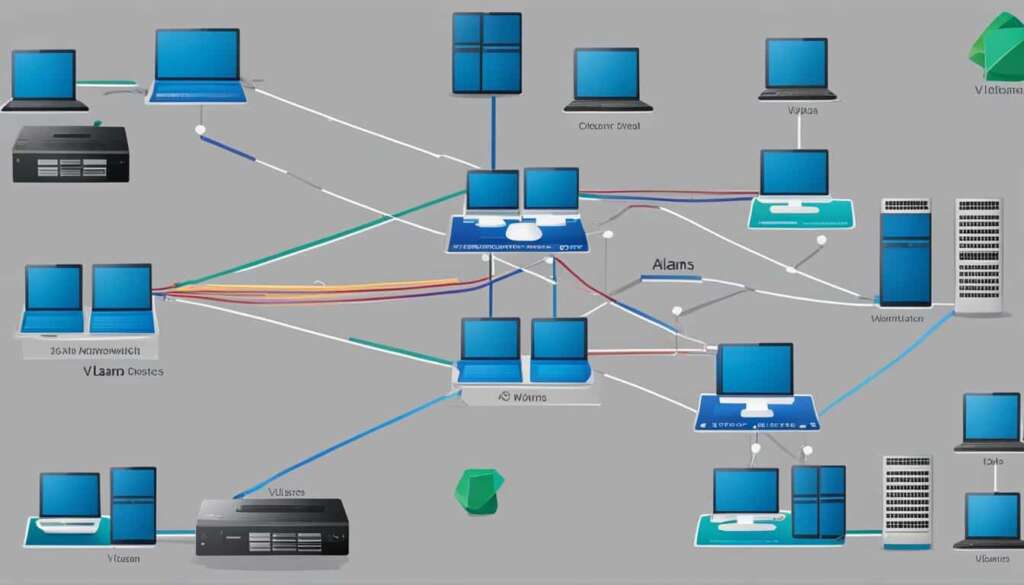Table of Contents
In the world of networking, VLANs (Virtual Local Area Networks) play a crucial role in optimizing network efficiency and resource utilization. But what exactly is a VLAN, and how does it work? In this article, we will dive into the basics of VLANs, exploring their definition, purpose, and benefits, as well as their configuration and applications.
What is a VLAN?
A VLAN, or virtual local area network, is a virtualized broadcast domain within a physical network. It allows for the logical separation of network devices into different virtual networks, without the need for physical separation. VLANs enable the creation of multiple virtual switches on a single physical switch, improving network segmentation, security, and efficiency.
VLANs revolutionize network design by providing the ability to create separate broadcast domains without the need for physical network infrastructure. With VLANs, network administrators can logically group devices into different virtual networks, effectively segmenting network traffic and enhancing security. This segregation helps prevent unnecessary broadcast traffic from flooding the entire network, ensuring that data is delivered only to the intended recipients.
Through VLAN technology, network administrators can isolate network traffic, enhance performance, and improve network management. By assigning VLAN tags to specific network devices, administrators can control how data is transmitted within the VLAN, ensuring that it is confined to the appropriate broadcast domain.
“VLANs provide an efficient way to organize and manage network resources. With VLANs, network administrators can easily control traffic flow, enhance security, and simplify network management.” – Michael Smith, Network Engineer
VLANs find applications in various industries and network environments. In enterprise networks, VLANs are commonly used to separate departments, allowing for granular access control and improved security. In data centers, VLANs help optimize resource allocation and enable seamless migration of virtual machines between servers. Additionally, VLANs are vital in virtualized environments, allowing virtual machines to be placed on different VLANs, ensuring secure communication within the virtual infrastructure.
The advantages of using VLANs include:
- Improved network segmentation and control
- Enhanced security by isolating traffic
- Efficient use of network resources
- Simplified network management and troubleshooting
By understanding the fundamentals of VLANs and their applications, network administrators can design and implement robust network infrastructures that meet the specific requirements of their organizations.
Broadcast Domain Basics
A broadcast domain refers to a specific network segment where hosts have the ability to send broadcast frames to each other. In an Ethernet network, there is a specific broadcast address, FF:FF:FF:FF:FF:FF, to which frames are sent and received by all hosts within the local network. When a host sends a broadcast frame, it is intended for every device within that broadcast domain.
Broadcast domains and IP subnets are often aligned, meaning that the broadcast domain corresponds to a specific IP subnet. However, it is important to note that this alignment is not a technical limitation. It is a common practice to keep broadcast domains and subnets small in order to improve network performance by reducing broadcast traffic that can consume valuable bandwidth.
Understanding the concept of broadcast domains is crucial in the management and configuration of Ethernet networks. By effectively controlling the size and scope of broadcast domains, network administrators can optimize network performance and maintain efficient communication between hosts.
Benefits of Small Broadcast Domains:
- Reduced network congestion: By limiting the size of the broadcast domain, the amount of broadcast traffic is minimized, preventing network congestion and improving overall network performance.
- Enhanced security: With smaller broadcast domains, it becomes easier to isolate and control network traffic, reducing the risk of unauthorized access or security breaches.
- Easier troubleshooting: When an issue arises within a broadcast domain, a smaller domain size makes it simpler to diagnose and troubleshoot the problem, minimizing downtime and improving network reliability.
By effectively managing broadcast domains and aligning them with IP subnets, network administrators can optimize network performance, enhance security, and streamline network troubleshooting processes.
| Broadcast Domain Basics | Benefits of Small Broadcast Domains |
|---|---|
| Defines a network segment where hosts can send broadcast frames to each other | Reduces network congestion |
| Corresponds to a specific IP subnet | Enhances security |
| Keeping broadcast domains and subnets small improves network performance | Simplifies troubleshooting processes |

VLAN Basics
VLANs, or Virtual Local Area Networks, play a vital role in network segmentation and efficiency. By creating virtual broadcast domains within a physical network, VLANs allow for the logical separation of network devices, improving network performance and security.
To configure VLANs, switches are used. Network ports on the switches are then configured to support VLANs. There are two main types of ports used in VLANs: access ports and trunk ports.
Access ports are used for hosts that only need to connect to a single VLAN. These ports provide network connectivity to devices within a specific VLAN and allow communication within that VLAN. Access ports are commonly used for end-user devices, such as computers or printers.
Trunk ports, on the other hand, are capable of carrying traffic for multiple VLANs on a single port. This means that multiple VLANs can be transmitted over a single physical connection. Trunk ports are typically used to connect switches together and facilitate inter-VLAN communication.
By utilizing VLANs, hosts within the same VLAN can communicate directly at the layer two data link layer without the need for routing. This improves network efficiency and reduces unnecessary traffic, ensuring that data is delivered to the intended recipients without unnecessary broadcast across the entire network.
With VLANs, network administrators can achieve better network organization, enhanced security, and improved efficiency. By logically separating devices into different virtual networks, VLANs enable efficient use of network resources and simplify network management.
“VLANs provide a flexible and scalable solution for managing and optimizing networks. By dividing a network into smaller, isolated domains, VLANs improve security, reduce broadcast traffic, and allow for efficient use of network resources.”
To further illustrate the concept of VLAN basics, refer to the table below:
| VLAN ID | VLAN Name | Description |
|---|---|---|
| 10 | Marketing | Devices used by the marketing team |
| 20 | Development | Devices used by the development team |
| 30 | Finance | Devices used by the finance team |
With the example above, devices belonging to the marketing team would be connected to access ports configured for VLAN 10. Similarly, devices belonging to the development team and finance team would be connected to access ports configured for VLANs 20 and 30, respectively.
VLAN Configuration and Trunk Ports
In order to effectively utilize VLANs within a network, configuration and the proper use of trunk ports are essential. Trunk ports play a critical role in facilitating the efficient transportation of traffic across multiple VLANs.
When configuring VLANs, switch ports can be assigned to specific VLANs based on their requirements. Access ports, for instance, facilitate the connection of hosts to a particular VLAN, allowing them to communicate within that virtual network.
On the other hand, trunk ports are designed to carry traffic for multiple VLANs simultaneously. This is achieved through the implementation of the IEEE 802.1Q protocol, which adds a special header to Ethernet frames. This additional header enables connected devices to differentiate between VLANs when receiving frames, ensuring that each VLAN’s traffic is appropriately routed.
Trunk ports serve a significant role in connecting switches together and supporting VLAN spanning. By carrying traffic for multiple VLANs, trunk ports enhance network flexibility and scalability.
To provide a more comprehensive understanding, consider the following example:
| Port Type | Description | Benefits |
|---|---|---|
| Access Port | Connects hosts to a specific VLAN |
|
| Trunk Port | Carries traffic for multiple VLANs |
|
Understanding VLAN configuration and the use of trunk ports is crucial for network administrators seeking to optimize network efficiency and ensure proper communication within VLANs. By appropriately configuring VLANs and leveraging trunk ports, organizations can create segmented networks that promote enhanced security, improved performance, and streamlined network management.
Native VLANs and Management Purposes
Native VLANs play a crucial role in network management and connectivity. These VLANs are carried on trunk ports without a VLAN tag, allowing them to be used without any special configuration or additional overhead. Native VLANs are particularly useful for management purposes, providing a simplified and efficient way to handle network administration tasks.
One common application of native VLANs is in hypervisor connectivity. In virtualized environments, a hypervisor may use a native VLAN for management traffic, enabling it to obtain an IP address through DHCP without the need for complex configuration. By utilizing a native VLAN, hypervisors can seamlessly connect to the network, simplifying the initial setup process.
Native VLANs also offer benefits in terms of ease of management and troubleshooting. By using a native VLAN, sysadmins can ensure that management traffic is segregated from user data traffic, making it easier to monitor and secure. Additionally, native VLANs provide initial connectivity for network devices, allowing sysadmins to quickly access and configure them.
“Native VLANs provide a simplified approach to network management and connectivity, making them an essential tool for sysadmins.”
To better understand the concept, let’s take a look at a simplified example:
| Scenario | VLAN Configuration |
|---|---|
| Native VLAN | VLAN 1 |
| Management VLAN | VLAN 10 |
As depicted in the table above, the native VLAN is VLAN 1, which is carried on trunk ports without a VLAN tag. This VLAN provides the initial connectivity for network devices, allowing for basic management tasks. On the other hand, VLAN 10 is dedicated to management traffic, ensuring that it remains separate from user data traffic.
Benefits of Native VLANs:
- Simplified management tasks
- Efficient hypervisor connectivity
- Separation of management traffic from user data traffic
- Quick initial connectivity for network devices
By leveraging native VLANs for management purposes, sysadmins can enhance network efficiency, streamline administration tasks, and improve overall network security. These VLANs provide a reliable foundation for managing network devices and maintaining seamless connectivity in complex environments.
VLANs and MAC Address Tables
Switches that support VLANs maintain MAC address tables that include VLAN information. MAC address tables map MAC addresses to switch ports, and VLAN-aware switches include the VLAN ID in the table entries. This allows switches to forward frames within the same VLAN and prevents traffic from crossing VLAN boundaries. VLANs and MAC address tables are essential for ensuring proper network segmentation and improving the efficiency and security of communication within VLANs.
Example of a MAC Address Table
| MAC Address | VLAN | Switch Port |
|---|---|---|
| 00:11:22:33:44:55 | 10 | Port 1 |
| 66:77:88:99:AA:BB | 20 | Port 2 |
| DD:EE:FF:11:22:33 | 10 | Port 3 |
- In the example above, the MAC address table lists MAC addresses, their corresponding VLANs, and the switch ports they are associated with.
- Each entry in the table represents a device connected to the switch.
- If a switch receives a frame with a destination MAC address in the table, it knows which VLAN and switch port to forward the frame to.
VLANs and MAC address tables play a crucial role in network segmentation, allowing organizations to create separate virtual networks and control traffic flow. By mapping MAC addresses to VLANs and switch ports, switches can efficiently direct traffic within VLANs, enhancing network security and performance.
Benefits and Applications of VLANs
VLANs provide numerous benefits that contribute to improved network efficiency, enhanced security, and simplified network troubleshooting. One of the key advantages of VLANs is network segmentation, which allows for the logical separation of network devices into different virtual networks. By segmenting the network, VLANs enable administrators to optimize network resources and improve overall performance.
Furthermore, VLANs play a vital role in enhancing network security. By isolating groups of devices into separate VLANs, administrators can implement stricter access controls and effectively minimize unauthorized access to sensitive data. VLANs also help contain network threats by preventing the spread of malicious activity within a specific VLAN, limiting the potential impact on the entire network.
In addition to segmentation and security, VLANs simplify network troubleshooting. By isolating specific groups of devices, administrators can easily identify and address network issues within a particular VLAN, without affecting other parts of the network. This targeted approach to troubleshooting minimizes downtime and allows for more efficient resolution of network problems.
Overall, understanding how to configure and troubleshoot VLANs is essential for network administrators to effectively leverage the benefits of VLANs and ensure the smooth operation of segmented networks. Whether in complex data center environments or virtualized setups, VLANs provide the versatility and flexibility required to support multiple logical networks, enabling organizations to optimize their network infrastructure in line with their specific requirements.
FAQ
What is a VLAN?
A VLAN, or virtual local area network, is a virtualized broadcast domain within a physical network. It allows for the logical separation of network devices into different virtual networks, without the need for physical separation.
What is a broadcast domain?
A broadcast domain is a network segment where hosts can send broadcast frames to each other. In an Ethernet network, the broadcast address is FF:FF:FF:FF:FF:FF, and frames sent to this address are received by all hosts on the local network.
How do VLANs improve network efficiency?
VLANs improve network efficiency by allowing hosts in the same VLAN to communicate directly at the layer two data link layer. This reduces the need for traffic to traverse multiple switches and improves overall network performance.
How are VLANs configured on switches?
VLANs are configured on switches, and switch ports are assigned to specific VLANs based on their requirements. Access ports connect to hosts in a single VLAN, while trunk ports carry traffic for multiple VLANs.
What is a trunk port?
A trunk port is a switch port that can carry traffic for multiple VLANs on a single port. Trunk ports use the IEEE 802.1Q protocol to add a special header to Ethernet frames, allowing the connected devices to differentiate between VLANs when receiving the frames.
What are native VLANs used for?
Native VLANs are carried on trunk ports without a VLAN tag and are used without any special configuration. They are often used for management purposes, such as allowing a hypervisor to obtain an IP address through DHCP without additional configuration.
How do VLANs improve network security?
VLANs improve network security by providing logical separation between different virtual networks. By isolating network traffic, VLANs can help prevent unauthorized access to sensitive data and reduce the impact of network threats.
What are the benefits of VLANs?
VLANs offer several benefits, including improved network efficiency, enhanced security, and simplified network troubleshooting. They enable network segmentation, allowing for the logical separation of network devices and the optimization of network resources.
In what environments are VLANs commonly used?
VLANs are commonly used in complex networks, such as data centers and virtualized environments, where the ability to support multiple logical networks is crucial. They are also used in larger office networks to improve network performance and security.













